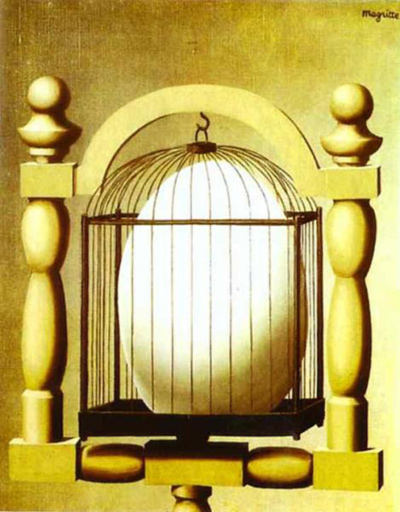Painted in oil on canvas in 1933, Elective Affinities (Les affinités électives in French) was created during the earlier part of Rene Magritte's career when he was in his mid thirties.
The work depicts a large egg in a birdcage suspended from a wooden stand. It is 41cm by 33cm and currently resides in a private collection. As with much of his work, and with much surrealist art, it depicts familiar objects, realistically reproduced, but in an unfamiliar, perhaps impossible setting.
According to the artist, the piece was inspired by a night when he awoke in a room containing a bird sleeping in a cage. In a magnificent error, he saw an egg in the cage instead of a bird. This led to him realising an astonishing poetic secret. His shock was due to to the affinity of the egg and the bird to each other, whereas previously it had been from his bringing together of two unrelated objects. Magritte seemed to like the aspect of mystery that his works produced, and often did not elaborate on their meaning. He said of his work that mystery means nothing - it is un-knowable.
The painting's name comes from the novel, Elective Affinities by Johann Wolfgang von Goethe, published in 1809. The novel's title was taken from an old chemistry term, and the story explores the laws of chemical affinity, or elective affinity, as a metaphor for human passions. Goethe seems to suggest that human interactions and relationships are ruled by similar laws to those that govern chemical interactions.
Several of Magritte's recurring themes can be seen in this work. The connection between an egg and a bird is seen in Perspicacity (1936), for example, and by placing the egg in a cage he explores the foolish human need to dominate or lock up others. The juxtaposition of familiar objects in unusual settings, as with the egg replacing the bird here, is a key feature of the Surrealist movement in which Magritte played an important part.




